Business in Practice: Evaluating Company Types, Structures, PESTLE
VerifiedAdded on 2023/01/05
|9
|2501
|84
Report
AI Summary
This report provides an analysis of business in practice, focusing on different types of companies, their organizational structures, and the external factors that influence their performance. It begins by categorizing companies based on size (micro, small, medium, and large) and legal structure (sole trader, partnership, limited liability, public limited liability, and cooperative). The report then examines functional and divisional organizational structures, highlighting their impact on efficiency and profitability. Finally, it conducts a PESTLE analysis to assess the political, economic, social, technological, legal, and environmental factors affecting business operations, using McDonald's as a case study to illustrate these factors. The report concludes that understanding these elements is crucial for businesses to navigate the market effectively and achieve their objectives. Desklib provides this document and many more solved assignments for students.
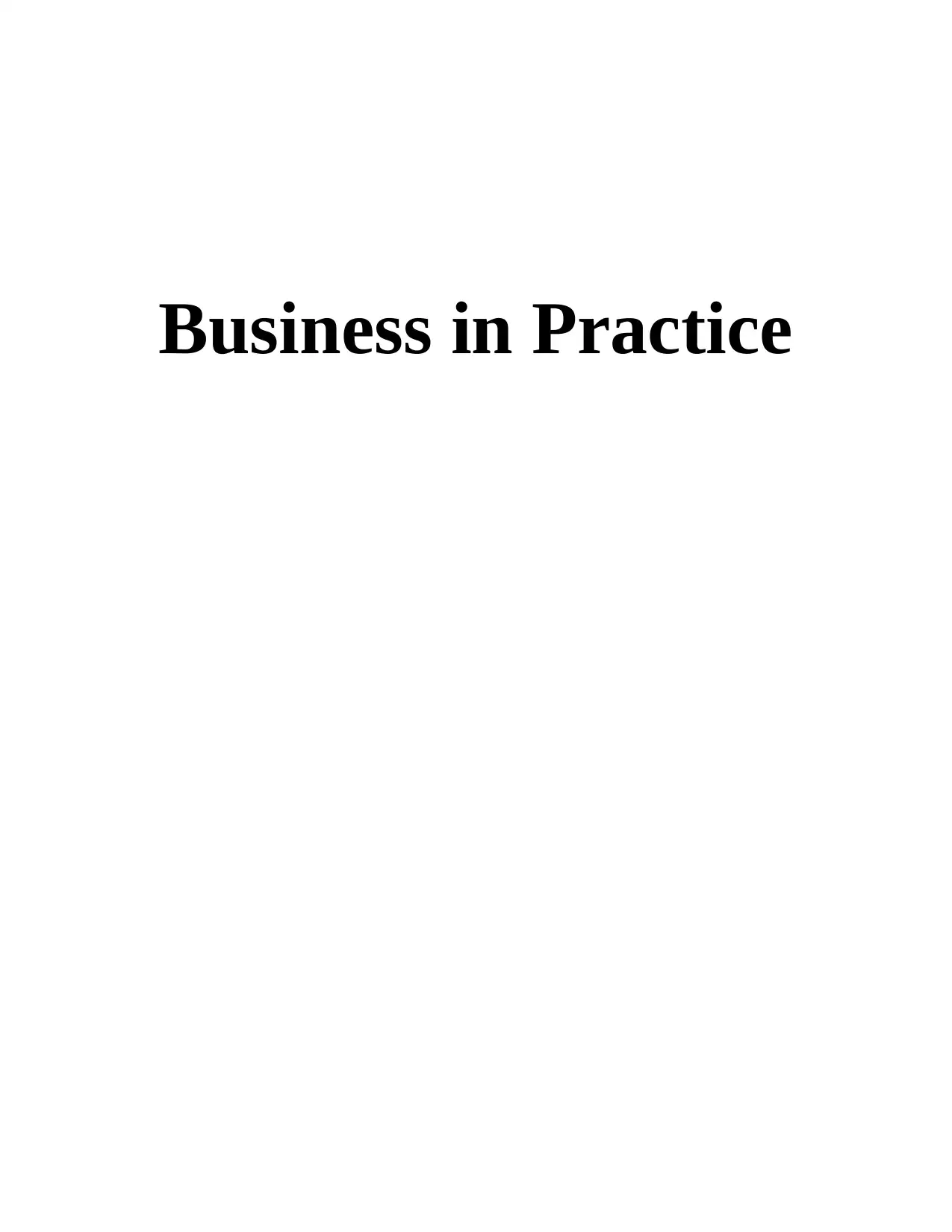
Business in Practice
Paraphrase This Document
Need a fresh take? Get an instant paraphrase of this document with our AI Paraphraser
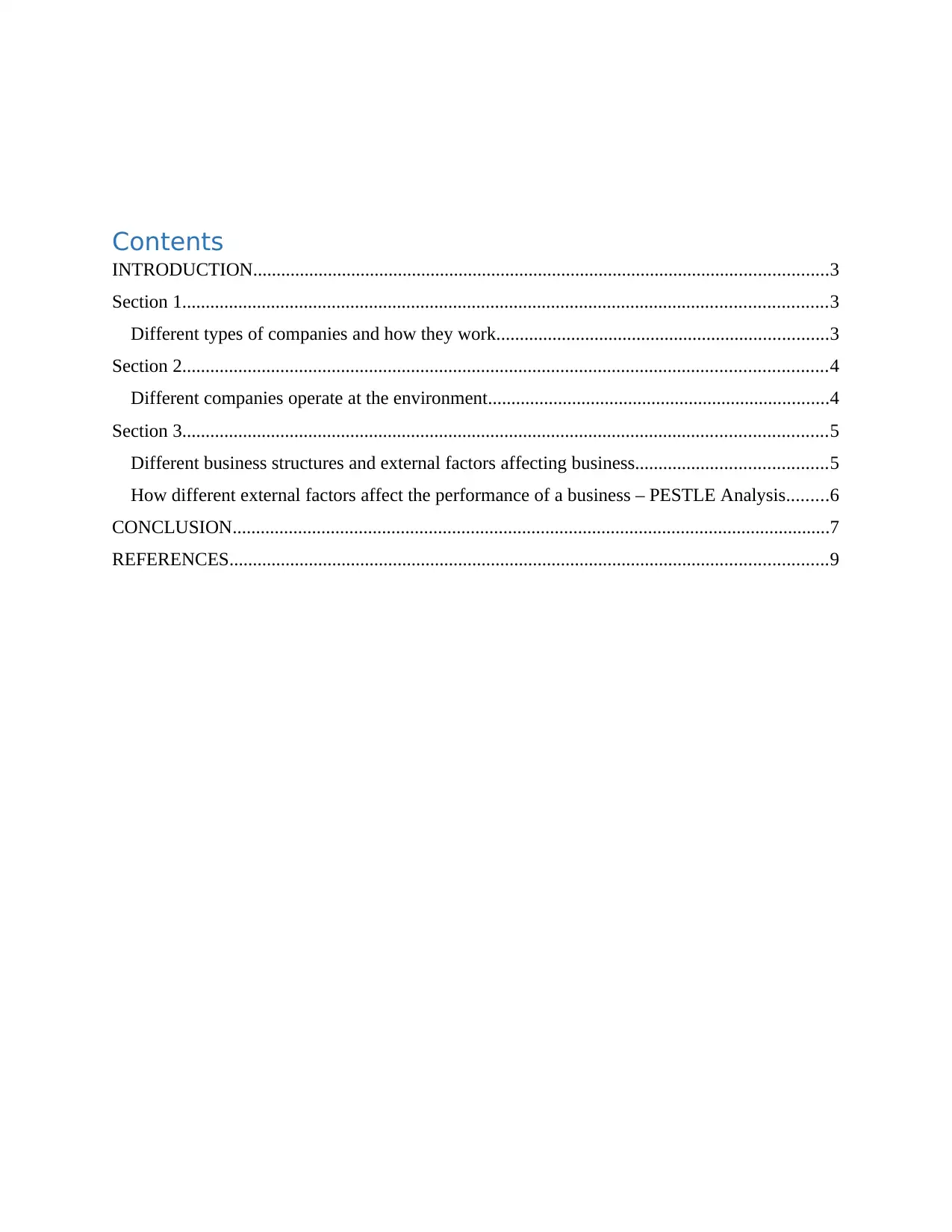
Contents
INTRODUCTION...........................................................................................................................3
Section 1..........................................................................................................................................3
Different types of companies and how they work.......................................................................3
Section 2..........................................................................................................................................4
Different companies operate at the environment.........................................................................4
Section 3..........................................................................................................................................5
Different business structures and external factors affecting business.........................................5
How different external factors affect the performance of a business – PESTLE Analysis.........6
CONCLUSION................................................................................................................................7
REFERENCES................................................................................................................................9
INTRODUCTION...........................................................................................................................3
Section 1..........................................................................................................................................3
Different types of companies and how they work.......................................................................3
Section 2..........................................................................................................................................4
Different companies operate at the environment.........................................................................4
Section 3..........................................................................................................................................5
Different business structures and external factors affecting business.........................................5
How different external factors affect the performance of a business – PESTLE Analysis.........6
CONCLUSION................................................................................................................................7
REFERENCES................................................................................................................................9
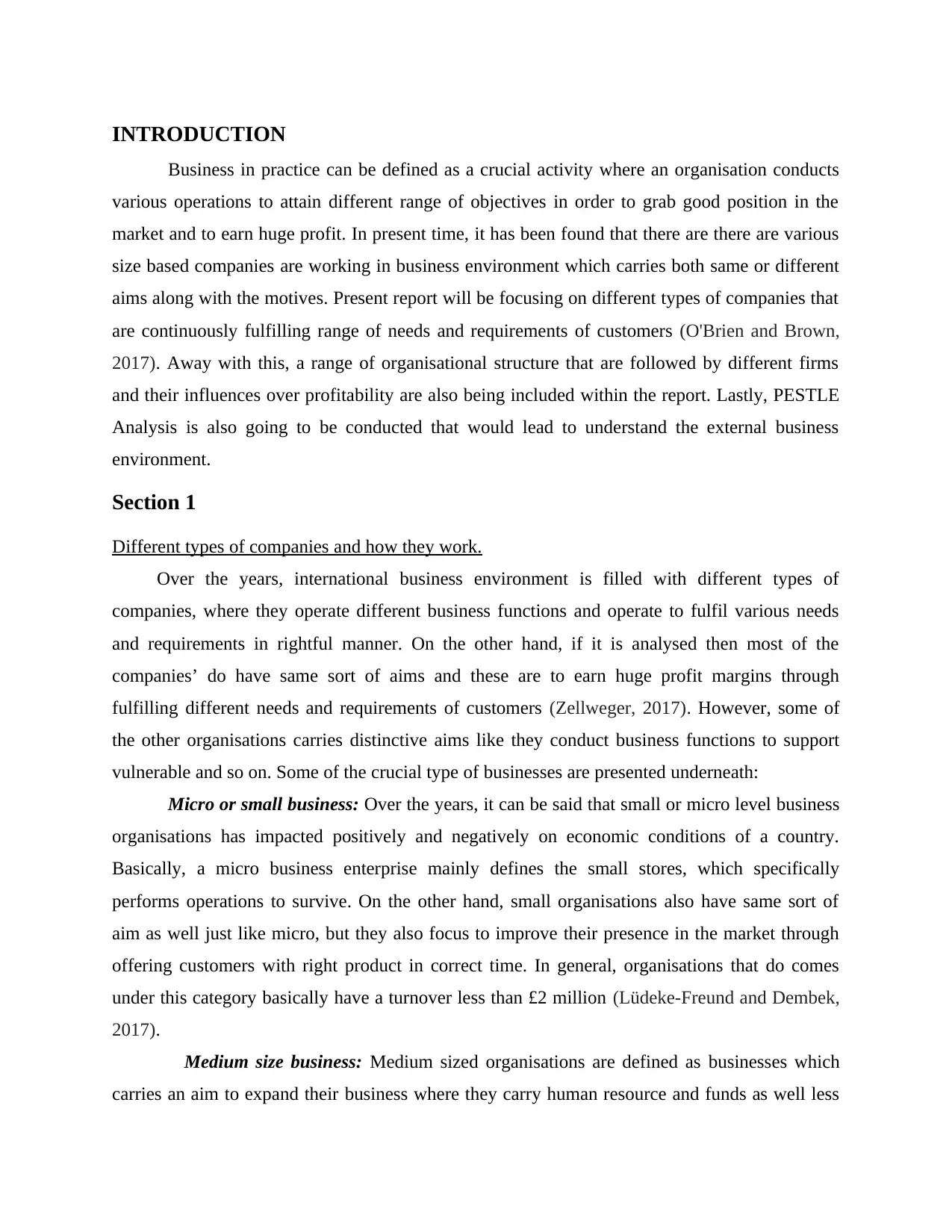
INTRODUCTION
Business in practice can be defined as a crucial activity where an organisation conducts
various operations to attain different range of objectives in order to grab good position in the
market and to earn huge profit. In present time, it has been found that there are there are various
size based companies are working in business environment which carries both same or different
aims along with the motives. Present report will be focusing on different types of companies that
are continuously fulfilling range of needs and requirements of customers (O'Brien and Brown,
2017). Away with this, a range of organisational structure that are followed by different firms
and their influences over profitability are also being included within the report. Lastly, PESTLE
Analysis is also going to be conducted that would lead to understand the external business
environment.
Section 1
Different types of companies and how they work.
Over the years, international business environment is filled with different types of
companies, where they operate different business functions and operate to fulfil various needs
and requirements in rightful manner. On the other hand, if it is analysed then most of the
companies’ do have same sort of aims and these are to earn huge profit margins through
fulfilling different needs and requirements of customers (Zellweger, 2017). However, some of
the other organisations carries distinctive aims like they conduct business functions to support
vulnerable and so on. Some of the crucial type of businesses are presented underneath:
Micro or small business: Over the years, it can be said that small or micro level business
organisations has impacted positively and negatively on economic conditions of a country.
Basically, a micro business enterprise mainly defines the small stores, which specifically
performs operations to survive. On the other hand, small organisations also have same sort of
aim as well just like micro, but they also focus to improve their presence in the market through
offering customers with right product in correct time. In general, organisations that do comes
under this category basically have a turnover less than £2 million (Lüdeke-Freund and Dembek,
2017).
Medium size business: Medium sized organisations are defined as businesses which
carries an aim to expand their business where they carry human resource and funds as well less
Business in practice can be defined as a crucial activity where an organisation conducts
various operations to attain different range of objectives in order to grab good position in the
market and to earn huge profit. In present time, it has been found that there are there are various
size based companies are working in business environment which carries both same or different
aims along with the motives. Present report will be focusing on different types of companies that
are continuously fulfilling range of needs and requirements of customers (O'Brien and Brown,
2017). Away with this, a range of organisational structure that are followed by different firms
and their influences over profitability are also being included within the report. Lastly, PESTLE
Analysis is also going to be conducted that would lead to understand the external business
environment.
Section 1
Different types of companies and how they work.
Over the years, international business environment is filled with different types of
companies, where they operate different business functions and operate to fulfil various needs
and requirements in rightful manner. On the other hand, if it is analysed then most of the
companies’ do have same sort of aims and these are to earn huge profit margins through
fulfilling different needs and requirements of customers (Zellweger, 2017). However, some of
the other organisations carries distinctive aims like they conduct business functions to support
vulnerable and so on. Some of the crucial type of businesses are presented underneath:
Micro or small business: Over the years, it can be said that small or micro level business
organisations has impacted positively and negatively on economic conditions of a country.
Basically, a micro business enterprise mainly defines the small stores, which specifically
performs operations to survive. On the other hand, small organisations also have same sort of
aim as well just like micro, but they also focus to improve their presence in the market through
offering customers with right product in correct time. In general, organisations that do comes
under this category basically have a turnover less than £2 million (Lüdeke-Freund and Dembek,
2017).
Medium size business: Medium sized organisations are defined as businesses which
carries an aim to expand their business where they carry human resource and funds as well less
⊘ This is a preview!⊘
Do you want full access?
Subscribe today to unlock all pages.

Trusted by 1+ million students worldwide
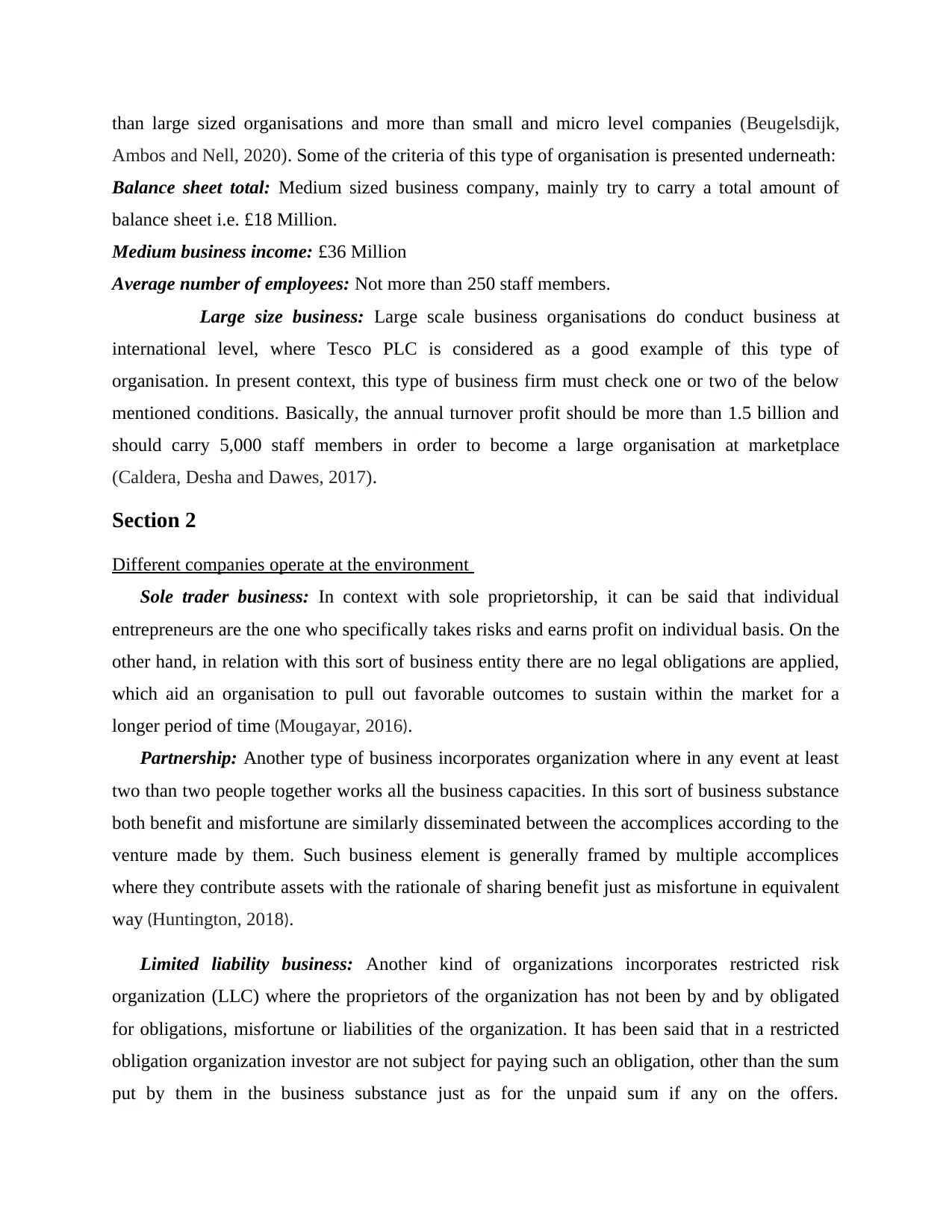
than large sized organisations and more than small and micro level companies (Beugelsdijk,
Ambos and Nell, 2020). Some of the criteria of this type of organisation is presented underneath:
Balance sheet total: Medium sized business company, mainly try to carry a total amount of
balance sheet i.e. £18 Million.
Medium business income: £36 Million
Average number of employees: Not more than 250 staff members.
Large size business: Large scale business organisations do conduct business at
international level, where Tesco PLC is considered as a good example of this type of
organisation. In present context, this type of business firm must check one or two of the below
mentioned conditions. Basically, the annual turnover profit should be more than 1.5 billion and
should carry 5,000 staff members in order to become a large organisation at marketplace
(Caldera, Desha and Dawes, 2017).
Section 2
Different companies operate at the environment
Sole trader business: In context with sole proprietorship, it can be said that individual
entrepreneurs are the one who specifically takes risks and earns profit on individual basis. On the
other hand, in relation with this sort of business entity there are no legal obligations are applied,
which aid an organisation to pull out favorable outcomes to sustain within the market for a
longer period of time (Mougayar, 2016).
Partnership: Another type of business incorporates organization where in any event at least
two than two people together works all the business capacities. In this sort of business substance
both benefit and misfortune are similarly disseminated between the accomplices according to the
venture made by them. Such business element is generally framed by multiple accomplices
where they contribute assets with the rationale of sharing benefit just as misfortune in equivalent
way (Huntington, 2018).
Limited liability business: Another kind of organizations incorporates restricted risk
organization (LLC) where the proprietors of the organization has not been by and by obligated
for obligations, misfortune or liabilities of the organization. It has been said that in a restricted
obligation organization investor are not subject for paying such an obligation, other than the sum
put by them in the business substance just as for the unpaid sum if any on the offers.
Ambos and Nell, 2020). Some of the criteria of this type of organisation is presented underneath:
Balance sheet total: Medium sized business company, mainly try to carry a total amount of
balance sheet i.e. £18 Million.
Medium business income: £36 Million
Average number of employees: Not more than 250 staff members.
Large size business: Large scale business organisations do conduct business at
international level, where Tesco PLC is considered as a good example of this type of
organisation. In present context, this type of business firm must check one or two of the below
mentioned conditions. Basically, the annual turnover profit should be more than 1.5 billion and
should carry 5,000 staff members in order to become a large organisation at marketplace
(Caldera, Desha and Dawes, 2017).
Section 2
Different companies operate at the environment
Sole trader business: In context with sole proprietorship, it can be said that individual
entrepreneurs are the one who specifically takes risks and earns profit on individual basis. On the
other hand, in relation with this sort of business entity there are no legal obligations are applied,
which aid an organisation to pull out favorable outcomes to sustain within the market for a
longer period of time (Mougayar, 2016).
Partnership: Another type of business incorporates organization where in any event at least
two than two people together works all the business capacities. In this sort of business substance
both benefit and misfortune are similarly disseminated between the accomplices according to the
venture made by them. Such business element is generally framed by multiple accomplices
where they contribute assets with the rationale of sharing benefit just as misfortune in equivalent
way (Huntington, 2018).
Limited liability business: Another kind of organizations incorporates restricted risk
organization (LLC) where the proprietors of the organization has not been by and by obligated
for obligations, misfortune or liabilities of the organization. It has been said that in a restricted
obligation organization investor are not subject for paying such an obligation, other than the sum
put by them in the business substance just as for the unpaid sum if any on the offers.
Paraphrase This Document
Need a fresh take? Get an instant paraphrase of this document with our AI Paraphraser
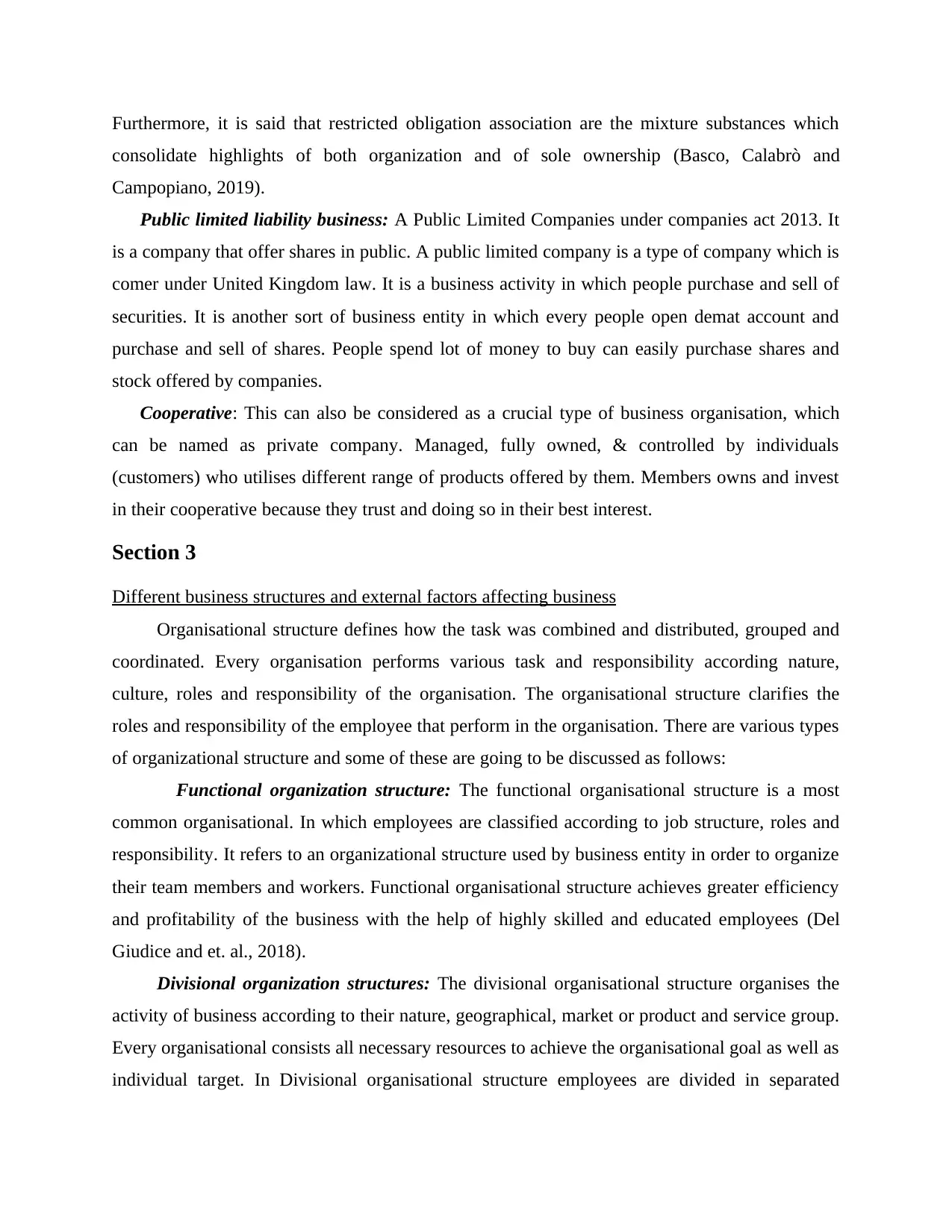
Furthermore, it is said that restricted obligation association are the mixture substances which
consolidate highlights of both organization and of sole ownership (Basco, Calabrò and
Campopiano, 2019).
Public limited liability business: A Public Limited Companies under companies act 2013. It
is a company that offer shares in public. A public limited company is a type of company which is
comer under United Kingdom law. It is a business activity in which people purchase and sell of
securities. It is another sort of business entity in which every people open demat account and
purchase and sell of shares. People spend lot of money to buy can easily purchase shares and
stock offered by companies.
Cooperative: This can also be considered as a crucial type of business organisation, which
can be named as private company. Managed, fully owned, & controlled by individuals
(customers) who utilises different range of products offered by them. Members owns and invest
in their cooperative because they trust and doing so in their best interest.
Section 3
Different business structures and external factors affecting business
Organisational structure defines how the task was combined and distributed, grouped and
coordinated. Every organisation performs various task and responsibility according nature,
culture, roles and responsibility of the organisation. The organisational structure clarifies the
roles and responsibility of the employee that perform in the organisation. There are various types
of organizational structure and some of these are going to be discussed as follows:
Functional organization structure: The functional organisational structure is a most
common organisational. In which employees are classified according to job structure, roles and
responsibility. It refers to an organizational structure used by business entity in order to organize
their team members and workers. Functional organisational structure achieves greater efficiency
and profitability of the business with the help of highly skilled and educated employees (Del
Giudice and et. al., 2018).
Divisional organization structures: The divisional organisational structure organises the
activity of business according to their nature, geographical, market or product and service group.
Every organisational consists all necessary resources to achieve the organisational goal as well as
individual target. In Divisional organisational structure employees are divided in separated
consolidate highlights of both organization and of sole ownership (Basco, Calabrò and
Campopiano, 2019).
Public limited liability business: A Public Limited Companies under companies act 2013. It
is a company that offer shares in public. A public limited company is a type of company which is
comer under United Kingdom law. It is a business activity in which people purchase and sell of
securities. It is another sort of business entity in which every people open demat account and
purchase and sell of shares. People spend lot of money to buy can easily purchase shares and
stock offered by companies.
Cooperative: This can also be considered as a crucial type of business organisation, which
can be named as private company. Managed, fully owned, & controlled by individuals
(customers) who utilises different range of products offered by them. Members owns and invest
in their cooperative because they trust and doing so in their best interest.
Section 3
Different business structures and external factors affecting business
Organisational structure defines how the task was combined and distributed, grouped and
coordinated. Every organisation performs various task and responsibility according nature,
culture, roles and responsibility of the organisation. The organisational structure clarifies the
roles and responsibility of the employee that perform in the organisation. There are various types
of organizational structure and some of these are going to be discussed as follows:
Functional organization structure: The functional organisational structure is a most
common organisational. In which employees are classified according to job structure, roles and
responsibility. It refers to an organizational structure used by business entity in order to organize
their team members and workers. Functional organisational structure achieves greater efficiency
and profitability of the business with the help of highly skilled and educated employees (Del
Giudice and et. al., 2018).
Divisional organization structures: The divisional organisational structure organises the
activity of business according to their nature, geographical, market or product and service group.
Every organisational consists all necessary resources to achieve the organisational goal as well as
individual target. In Divisional organisational structure employees are divided in separated
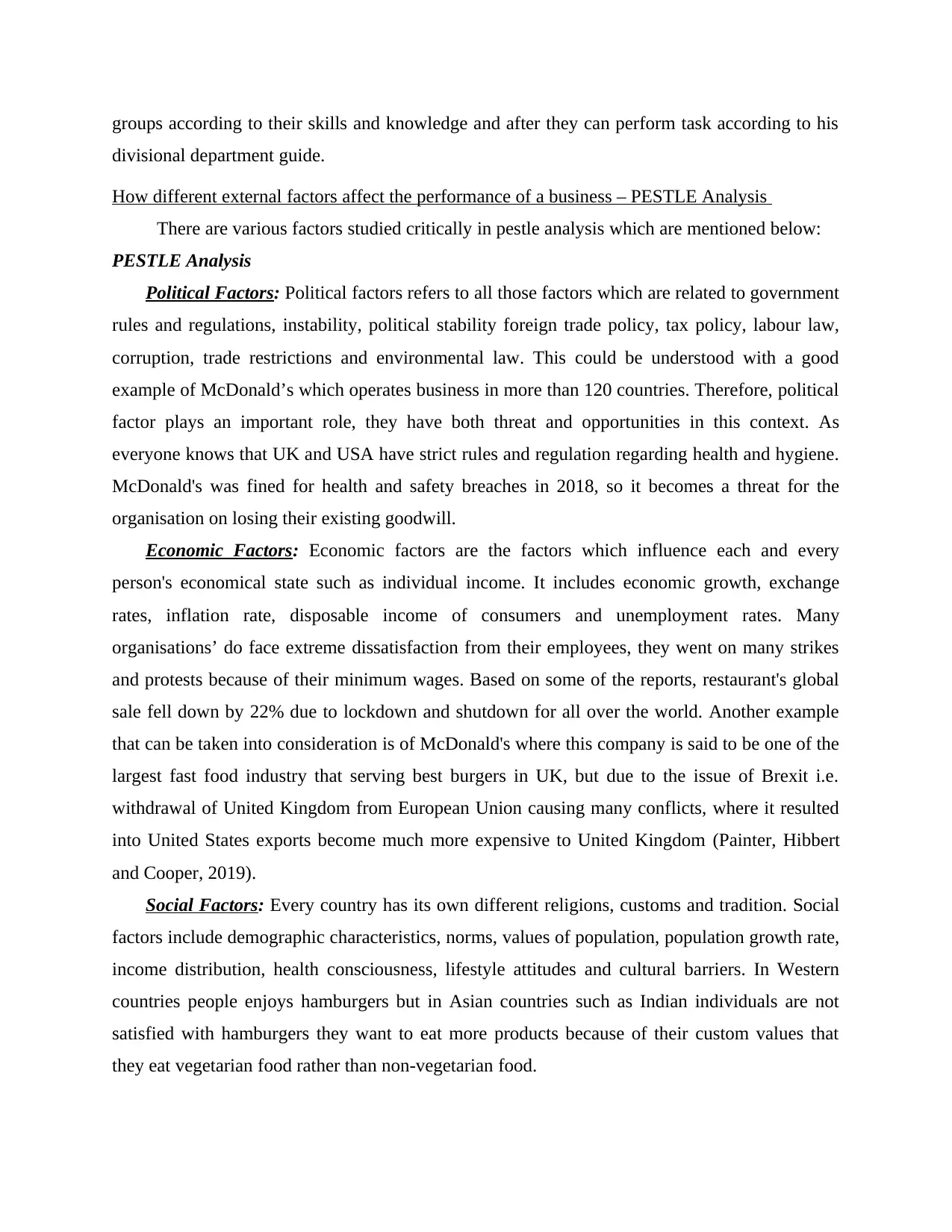
groups according to their skills and knowledge and after they can perform task according to his
divisional department guide.
How different external factors affect the performance of a business – PESTLE Analysis
There are various factors studied critically in pestle analysis which are mentioned below:
PESTLE Analysis
Political Factors: Political factors refers to all those factors which are related to government
rules and regulations, instability, political stability foreign trade policy, tax policy, labour law,
corruption, trade restrictions and environmental law. This could be understood with a good
example of McDonald’s which operates business in more than 120 countries. Therefore, political
factor plays an important role, they have both threat and opportunities in this context. As
everyone knows that UK and USA have strict rules and regulation regarding health and hygiene.
McDonald's was fined for health and safety breaches in 2018, so it becomes a threat for the
organisation on losing their existing goodwill.
Economic Factors: Economic factors are the factors which influence each and every
person's economical state such as individual income. It includes economic growth, exchange
rates, inflation rate, disposable income of consumers and unemployment rates. Many
organisations’ do face extreme dissatisfaction from their employees, they went on many strikes
and protests because of their minimum wages. Based on some of the reports, restaurant's global
sale fell down by 22% due to lockdown and shutdown for all over the world. Another example
that can be taken into consideration is of McDonald's where this company is said to be one of the
largest fast food industry that serving best burgers in UK, but due to the issue of Brexit i.e.
withdrawal of United Kingdom from European Union causing many conflicts, where it resulted
into United States exports become much more expensive to United Kingdom (Painter, Hibbert
and Cooper, 2019).
Social Factors: Every country has its own different religions, customs and tradition. Social
factors include demographic characteristics, norms, values of population, population growth rate,
income distribution, health consciousness, lifestyle attitudes and cultural barriers. In Western
countries people enjoys hamburgers but in Asian countries such as Indian individuals are not
satisfied with hamburgers they want to eat more products because of their custom values that
they eat vegetarian food rather than non-vegetarian food.
divisional department guide.
How different external factors affect the performance of a business – PESTLE Analysis
There are various factors studied critically in pestle analysis which are mentioned below:
PESTLE Analysis
Political Factors: Political factors refers to all those factors which are related to government
rules and regulations, instability, political stability foreign trade policy, tax policy, labour law,
corruption, trade restrictions and environmental law. This could be understood with a good
example of McDonald’s which operates business in more than 120 countries. Therefore, political
factor plays an important role, they have both threat and opportunities in this context. As
everyone knows that UK and USA have strict rules and regulation regarding health and hygiene.
McDonald's was fined for health and safety breaches in 2018, so it becomes a threat for the
organisation on losing their existing goodwill.
Economic Factors: Economic factors are the factors which influence each and every
person's economical state such as individual income. It includes economic growth, exchange
rates, inflation rate, disposable income of consumers and unemployment rates. Many
organisations’ do face extreme dissatisfaction from their employees, they went on many strikes
and protests because of their minimum wages. Based on some of the reports, restaurant's global
sale fell down by 22% due to lockdown and shutdown for all over the world. Another example
that can be taken into consideration is of McDonald's where this company is said to be one of the
largest fast food industry that serving best burgers in UK, but due to the issue of Brexit i.e.
withdrawal of United Kingdom from European Union causing many conflicts, where it resulted
into United States exports become much more expensive to United Kingdom (Painter, Hibbert
and Cooper, 2019).
Social Factors: Every country has its own different religions, customs and tradition. Social
factors include demographic characteristics, norms, values of population, population growth rate,
income distribution, health consciousness, lifestyle attitudes and cultural barriers. In Western
countries people enjoys hamburgers but in Asian countries such as Indian individuals are not
satisfied with hamburgers they want to eat more products because of their custom values that
they eat vegetarian food rather than non-vegetarian food.
⊘ This is a preview!⊘
Do you want full access?
Subscribe today to unlock all pages.

Trusted by 1+ million students worldwide
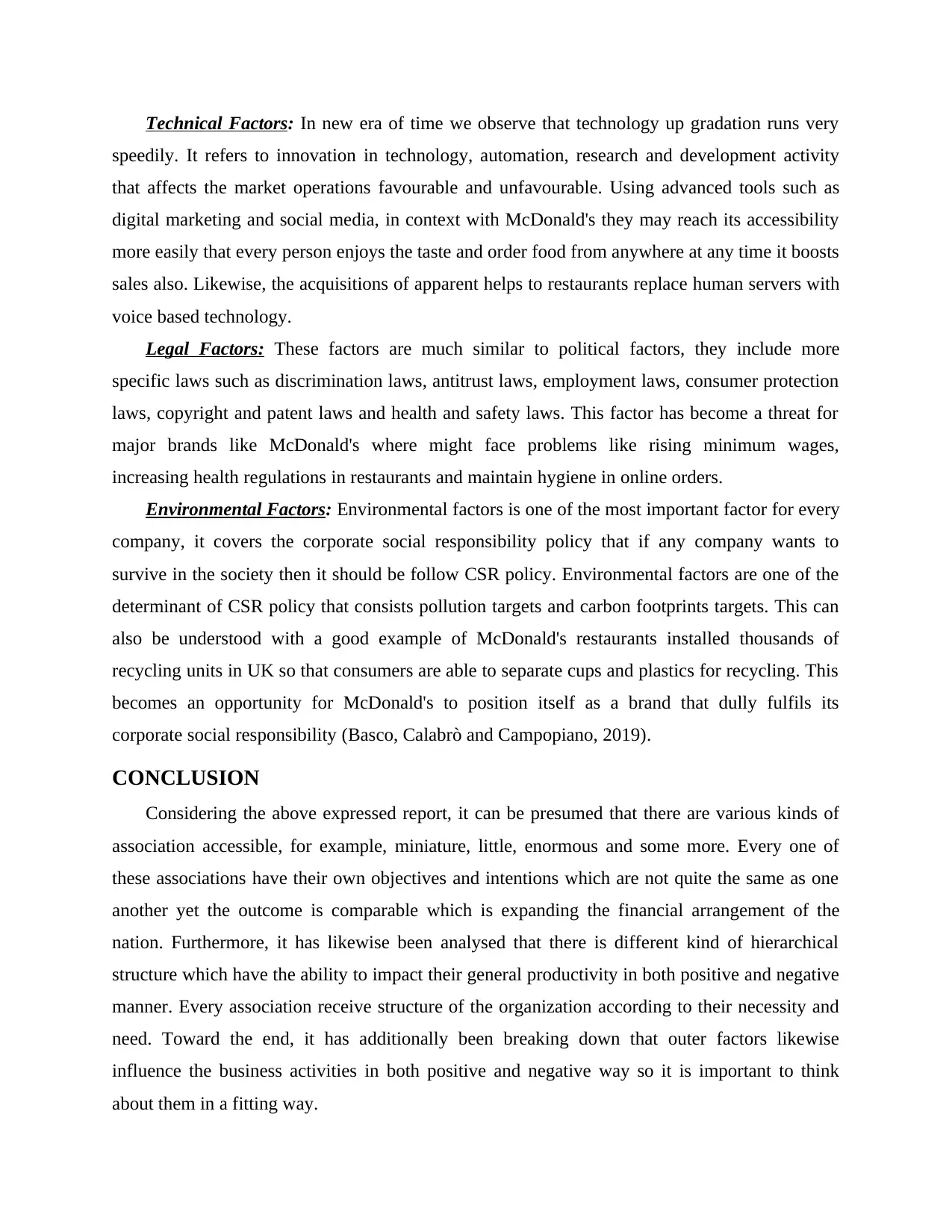
Technical Factors: In new era of time we observe that technology up gradation runs very
speedily. It refers to innovation in technology, automation, research and development activity
that affects the market operations favourable and unfavourable. Using advanced tools such as
digital marketing and social media, in context with McDonald's they may reach its accessibility
more easily that every person enjoys the taste and order food from anywhere at any time it boosts
sales also. Likewise, the acquisitions of apparent helps to restaurants replace human servers with
voice based technology.
Legal Factors: These factors are much similar to political factors, they include more
specific laws such as discrimination laws, antitrust laws, employment laws, consumer protection
laws, copyright and patent laws and health and safety laws. This factor has become a threat for
major brands like McDonald's where might face problems like rising minimum wages,
increasing health regulations in restaurants and maintain hygiene in online orders.
Environmental Factors: Environmental factors is one of the most important factor for every
company, it covers the corporate social responsibility policy that if any company wants to
survive in the society then it should be follow CSR policy. Environmental factors are one of the
determinant of CSR policy that consists pollution targets and carbon footprints targets. This can
also be understood with a good example of McDonald's restaurants installed thousands of
recycling units in UK so that consumers are able to separate cups and plastics for recycling. This
becomes an opportunity for McDonald's to position itself as a brand that dully fulfils its
corporate social responsibility (Basco, Calabrò and Campopiano, 2019).
CONCLUSION
Considering the above expressed report, it can be presumed that there are various kinds of
association accessible, for example, miniature, little, enormous and some more. Every one of
these associations have their own objectives and intentions which are not quite the same as one
another yet the outcome is comparable which is expanding the financial arrangement of the
nation. Furthermore, it has likewise been analysed that there is different kind of hierarchical
structure which have the ability to impact their general productivity in both positive and negative
manner. Every association receive structure of the organization according to their necessity and
need. Toward the end, it has additionally been breaking down that outer factors likewise
influence the business activities in both positive and negative way so it is important to think
about them in a fitting way.
speedily. It refers to innovation in technology, automation, research and development activity
that affects the market operations favourable and unfavourable. Using advanced tools such as
digital marketing and social media, in context with McDonald's they may reach its accessibility
more easily that every person enjoys the taste and order food from anywhere at any time it boosts
sales also. Likewise, the acquisitions of apparent helps to restaurants replace human servers with
voice based technology.
Legal Factors: These factors are much similar to political factors, they include more
specific laws such as discrimination laws, antitrust laws, employment laws, consumer protection
laws, copyright and patent laws and health and safety laws. This factor has become a threat for
major brands like McDonald's where might face problems like rising minimum wages,
increasing health regulations in restaurants and maintain hygiene in online orders.
Environmental Factors: Environmental factors is one of the most important factor for every
company, it covers the corporate social responsibility policy that if any company wants to
survive in the society then it should be follow CSR policy. Environmental factors are one of the
determinant of CSR policy that consists pollution targets and carbon footprints targets. This can
also be understood with a good example of McDonald's restaurants installed thousands of
recycling units in UK so that consumers are able to separate cups and plastics for recycling. This
becomes an opportunity for McDonald's to position itself as a brand that dully fulfils its
corporate social responsibility (Basco, Calabrò and Campopiano, 2019).
CONCLUSION
Considering the above expressed report, it can be presumed that there are various kinds of
association accessible, for example, miniature, little, enormous and some more. Every one of
these associations have their own objectives and intentions which are not quite the same as one
another yet the outcome is comparable which is expanding the financial arrangement of the
nation. Furthermore, it has likewise been analysed that there is different kind of hierarchical
structure which have the ability to impact their general productivity in both positive and negative
manner. Every association receive structure of the organization according to their necessity and
need. Toward the end, it has additionally been breaking down that outer factors likewise
influence the business activities in both positive and negative way so it is important to think
about them in a fitting way.
Paraphrase This Document
Need a fresh take? Get an instant paraphrase of this document with our AI Paraphraser

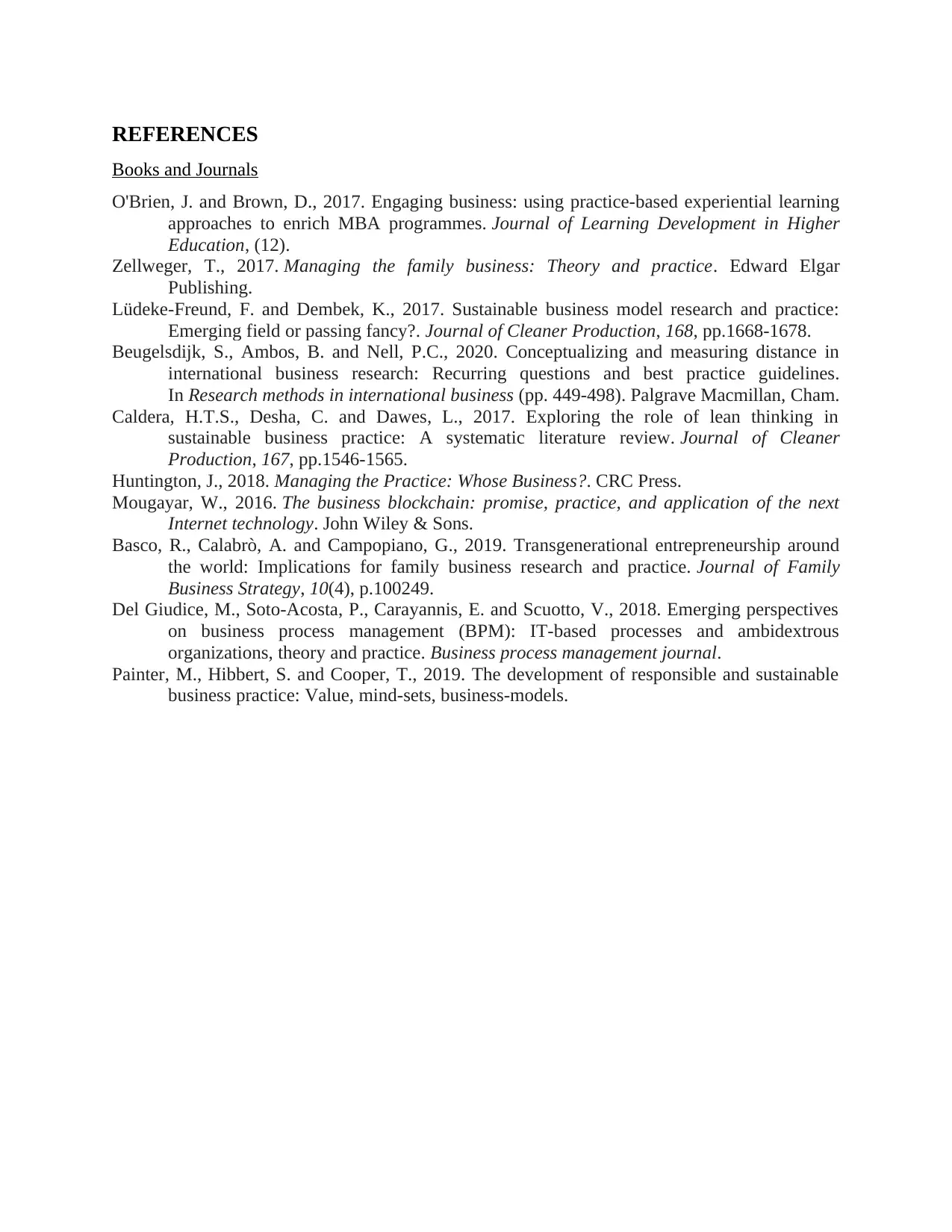
REFERENCES
Books and Journals
O'Brien, J. and Brown, D., 2017. Engaging business: using practice-based experiential learning
approaches to enrich MBA programmes. Journal of Learning Development in Higher
Education, (12).
Zellweger, T., 2017. Managing the family business: Theory and practice. Edward Elgar
Publishing.
Lüdeke-Freund, F. and Dembek, K., 2017. Sustainable business model research and practice:
Emerging field or passing fancy?. Journal of Cleaner Production, 168, pp.1668-1678.
Beugelsdijk, S., Ambos, B. and Nell, P.C., 2020. Conceptualizing and measuring distance in
international business research: Recurring questions and best practice guidelines.
In Research methods in international business (pp. 449-498). Palgrave Macmillan, Cham.
Caldera, H.T.S., Desha, C. and Dawes, L., 2017. Exploring the role of lean thinking in
sustainable business practice: A systematic literature review. Journal of Cleaner
Production, 167, pp.1546-1565.
Huntington, J., 2018. Managing the Practice: Whose Business?. CRC Press.
Mougayar, W., 2016. The business blockchain: promise, practice, and application of the next
Internet technology. John Wiley & Sons.
Basco, R., Calabrò, A. and Campopiano, G., 2019. Transgenerational entrepreneurship around
the world: Implications for family business research and practice. Journal of Family
Business Strategy, 10(4), p.100249.
Del Giudice, M., Soto-Acosta, P., Carayannis, E. and Scuotto, V., 2018. Emerging perspectives
on business process management (BPM): IT-based processes and ambidextrous
organizations, theory and practice. Business process management journal.
Painter, M., Hibbert, S. and Cooper, T., 2019. The development of responsible and sustainable
business practice: Value, mind-sets, business-models.
Books and Journals
O'Brien, J. and Brown, D., 2017. Engaging business: using practice-based experiential learning
approaches to enrich MBA programmes. Journal of Learning Development in Higher
Education, (12).
Zellweger, T., 2017. Managing the family business: Theory and practice. Edward Elgar
Publishing.
Lüdeke-Freund, F. and Dembek, K., 2017. Sustainable business model research and practice:
Emerging field or passing fancy?. Journal of Cleaner Production, 168, pp.1668-1678.
Beugelsdijk, S., Ambos, B. and Nell, P.C., 2020. Conceptualizing and measuring distance in
international business research: Recurring questions and best practice guidelines.
In Research methods in international business (pp. 449-498). Palgrave Macmillan, Cham.
Caldera, H.T.S., Desha, C. and Dawes, L., 2017. Exploring the role of lean thinking in
sustainable business practice: A systematic literature review. Journal of Cleaner
Production, 167, pp.1546-1565.
Huntington, J., 2018. Managing the Practice: Whose Business?. CRC Press.
Mougayar, W., 2016. The business blockchain: promise, practice, and application of the next
Internet technology. John Wiley & Sons.
Basco, R., Calabrò, A. and Campopiano, G., 2019. Transgenerational entrepreneurship around
the world: Implications for family business research and practice. Journal of Family
Business Strategy, 10(4), p.100249.
Del Giudice, M., Soto-Acosta, P., Carayannis, E. and Scuotto, V., 2018. Emerging perspectives
on business process management (BPM): IT-based processes and ambidextrous
organizations, theory and practice. Business process management journal.
Painter, M., Hibbert, S. and Cooper, T., 2019. The development of responsible and sustainable
business practice: Value, mind-sets, business-models.
⊘ This is a preview!⊘
Do you want full access?
Subscribe today to unlock all pages.

Trusted by 1+ million students worldwide
1 out of 9
Related Documents
Your All-in-One AI-Powered Toolkit for Academic Success.
+13062052269
info@desklib.com
Available 24*7 on WhatsApp / Email
![[object Object]](/_next/static/media/star-bottom.7253800d.svg)
Unlock your academic potential
Copyright © 2020–2025 A2Z Services. All Rights Reserved. Developed and managed by ZUCOL.





